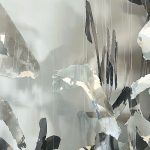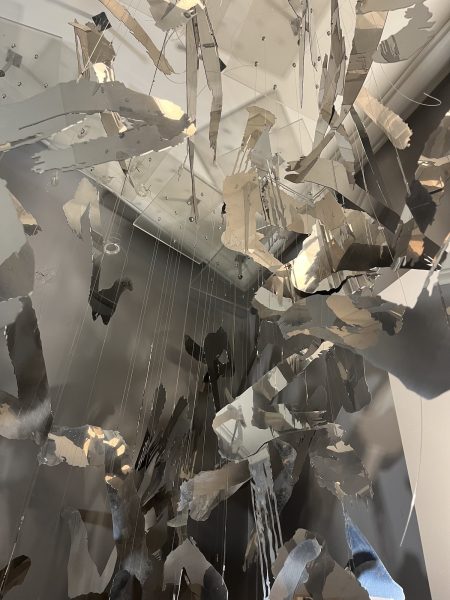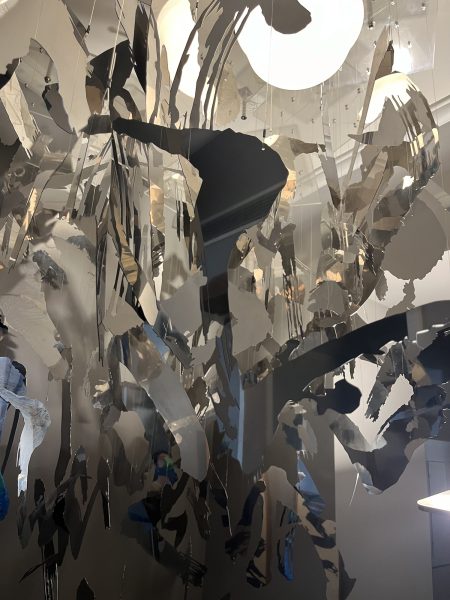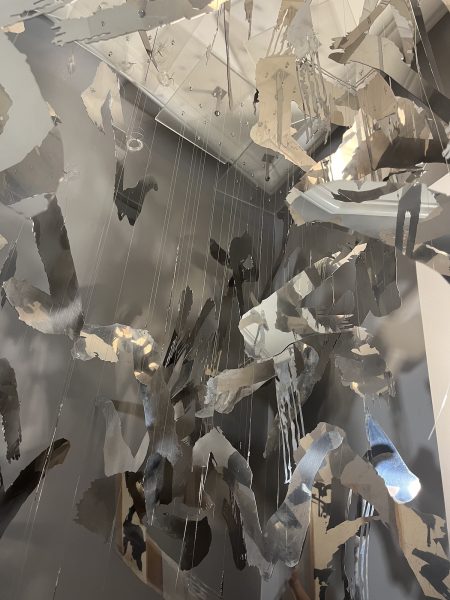“Communion Constellation” presented during the 53rd Venice Biennale
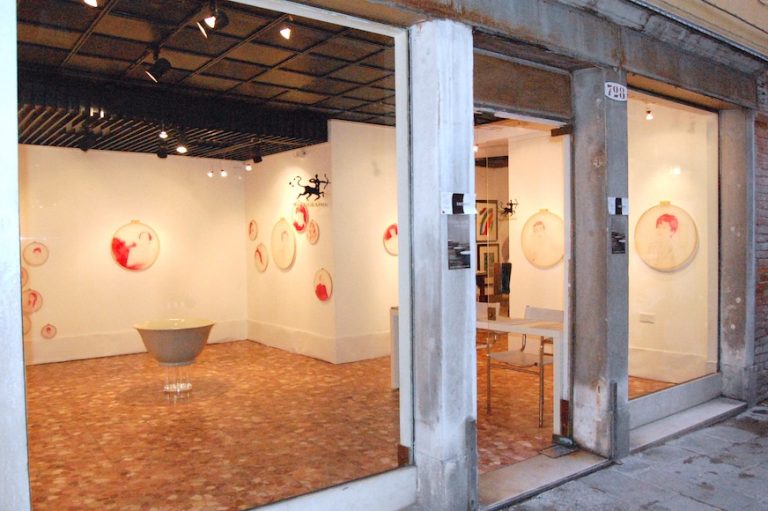
Communion | Constellation
Installation view, Venice, Italy
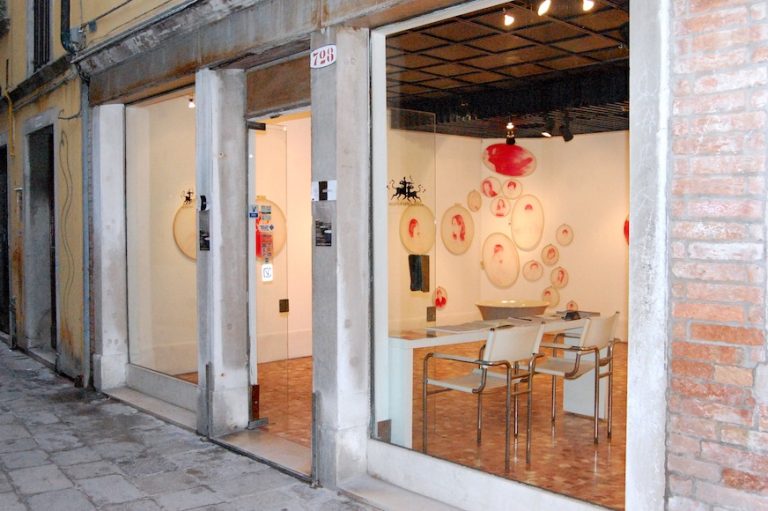
Communion | Constellation
Installation view, Venice, Italy
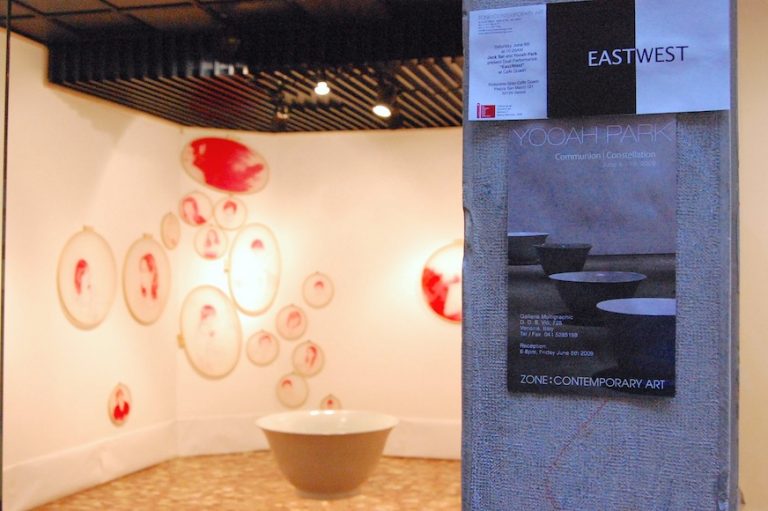
Communion | Constellation
Installation view, Venice, Italy
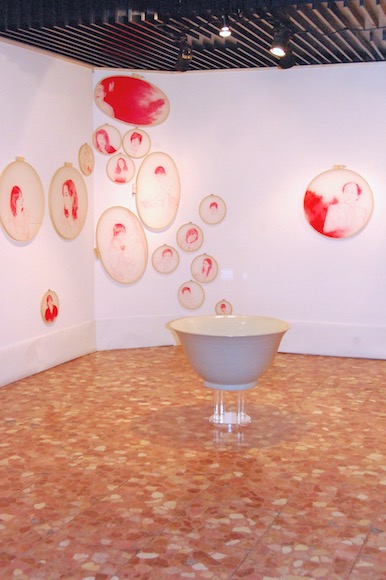
Communion | Constellation
Installation view, Venice, Italy
ZONE CONTEMPORARY ART is proud to present “Communion/Constellation,” a solo exhibition by gallery artist Yooah Park, on the occasion of the 53rd Venice Biennale. ZONE’s mission of global artistic interchange reflects the main theme of the Biennale, “ Making Worlds.”
“Communion/Constellation” establishes an intimate gathering space, exploring the circle form in various mediums. Portraits of family and friends cluster around a communal rice bowl. A universal symbol of plenty, of physical and spiritual nourishment, of vitality and renewal, the ceramic bowel has historically been an integral part of Korean culture. While majestic in scale, Yooah’s vessel seems almost weightless because of the delicacy of its celadon glaze. The gentle irregularities of the bowl are an eloquent reminder of the casting process, in which dynamic forces are guarded by the artist’s shaping hand and eye. The large and small tondo paintings are executed in red on a translucent, skin-like fabric of liquid vinyl. The refined draftsmanship of the portraits is reminiscent of old master drawings, while the luminosity of the materials suggests grisaille stained glass.
Trained as a traditional brush painter Yooah extends the gestural language of calligraphy onto these evocations of people vital to her personal constellation. The red ink, or Gyong-myon-ju-sa, is a mineral pigment of cinnabar, mercury and sulfur (HgS). In alchemy, sulfur is considered to be a condensation of positiveness, and mercury is thought to be a condensation of negativeness. Combined, they create a mysterious power that wards off evil. The minerals are mixed with cinnabar and perilla-oil. Unlike many other pigments, Gyong-myon-ju-sa is highly stable: the ink will be permanent until the support disintegrates. Because Yooah used the high-tech liquid vinyl, instead of the traditional paper, her images will last even longer. Like an alchemist, the painter is adept in the art of mixing delicate and dangerous elements. Gyong-myon-ju-sa, also called Inju, is used to create Bujeok, small talismans, carried for protection or posted at certain plays in and around the house: over a door or gate or on the ceiling. The blood-red color and viscosity of Inju also allude to sealing wax and colophon signatures. In both paintings and ceramics, the artist manipulates raw materials to liberate the spirit within.
Parallel Event:
On Saturday, June 6th at 10:00AM, New York based Zone Artists Jack Sal and Yooah Park will present a Dual Performance entitled “East/West” at Caffé Quadri on the historical Piazza San Marco.* Sal, who has participated in numerous exhibitions, projects, and events for past Biennales, will continue his performances with coffee and other elements and will be joined for the first time by another artist. In this first occasion, a collaboration has been established with Yooah Park, whose work with tea and other traditional Asian foods creates a contrast/mirror to Sal’s ongoing activities in Venice.
* Ristorante Gran Caffé Quadri
Piazza San Marco 121
30124 Venice
Yooah Park
Communion/Constellation
June 5 – June 19, 2009
Opening reception: 6-8pm, June 5
Galleria Multigraphic
D.D.S. Vio 728 Venezia, Italy
The frame of needlework, the surface of vinyl, the subtle trace of ink. Drawn from a feminine world, Yooah Park opens an external world, the private. The intimate fabric of relationships based on affection, estimate, and respect that the artist, who has lived in New York these past years, links to her family and close friends.
There are her children, Candy e Davis Koh; her father T. J. Park, her mother O. J. Jang and her sister Jinah; her teacher Jong Sang Lee, the celebrated author Jung Rae Cho as well as her dog City represented along with her owner.
A flow of reciprocal exchanges with which Yooah Park renders homage by offering of herself, using the metaphor of food (rice), represented indirectly by the large hand-thrown bowl that is then placed in the kiln for its double firing. Always experimenting with techniques and materials, the artist emphasizes here again in her first one-person exhibition in Italy, Communion/Constellation – the matrix of her artistic language: the calligraphic tradition.
Black ink –dominated her previous works, including the series Untitled (Small Pulp) from 2000 and, in particular, transposed into metal in Writing in the Void (2006). Here it is “illuminated” (using a term borrowed from the ancient miniaturists) with the substitution of the brilliant tonality of cinnabar, mixed with other natural elements including cooking oil: creating a dense non-toxic liquid (Inju), used for seals. With a fine-point brush, like the needles used in needlework, the artist traces with confidence the outline of the precise identity of her subjects. Memory is represented via the photographs always taken by the artist – an intermediary vehicle important to suspend real time, and to avoid the “staged.” There is not a gaze, amongst the many subjects even though intense, that directly engages the viewer. It does not make for good manners, based on modesty and reserve as used in the East, to look someone directly in the eyes. Nevertheless, the rules of the traditional portrait require that the focal point be the face, rendering as secondary importance all other information.
In reference to this stylistic cannon, Park concentrates on the face, leaving clothing and objects that are normally used to describe the subject as sketchy traces. If, in the past, she has created handmade paper on which she paints freely interpreted ideograms, in Communion/Constellation she chooses as a support a light and flexible material – Liquid Vinyl – used as well in the textile industry. Among its fundamental characteristics is its transparency: through its interaction with light, whose source could be from either the front or the back and is revealed in the details (the eyes, the hair, half smiles).
Thirteen – a known symbolic number, within both Eastern and Western cultures – is an apparent reference to “The Last Supper.” Thirteen is in fact the number of large circular portraits from this type of a family album, surrounded by a “constellation” of smaller circles as well as some ovals. Using the cinnabar, which is also used in traditional medicine as well as in the creation of amulets against the evil eye, the artist takes on the role of the shaman. Painting the faces of her family and important friends becomes a way of caring for them as well as to protect them. As in her use of the food/nutrition, which is alluded to by the presence of the bowl, and is associated psychologically to giving (or withholding) affection. A dialogue that opens new and more complex thoughts.
Manuela de Leonardis is a Rome, Italy based curator, critic, and journalist whose articles and exhibitions feature contemporary art and photography.
Related:
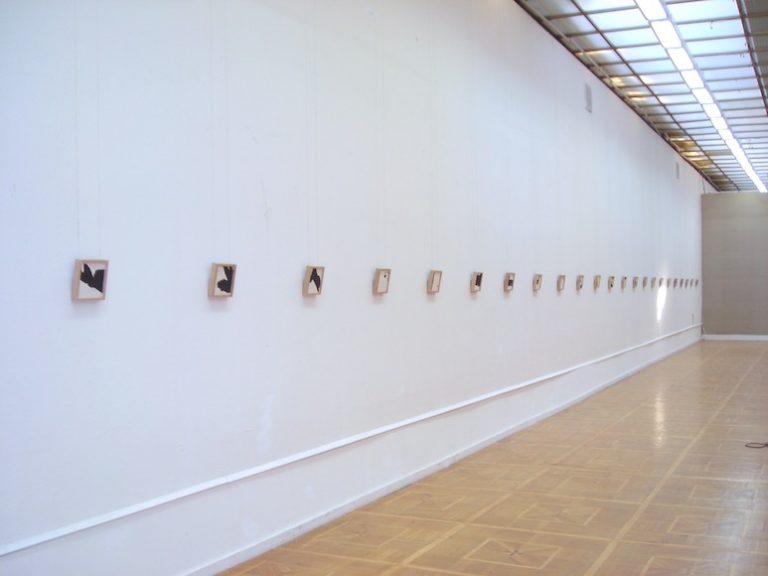
Yooah Park: “Writing in the Void”
Categories: projects
Tags: Yooah Park
Yooah Park: “Writing in the Void”

Central House of Artists Museum, Moscow
Installation view
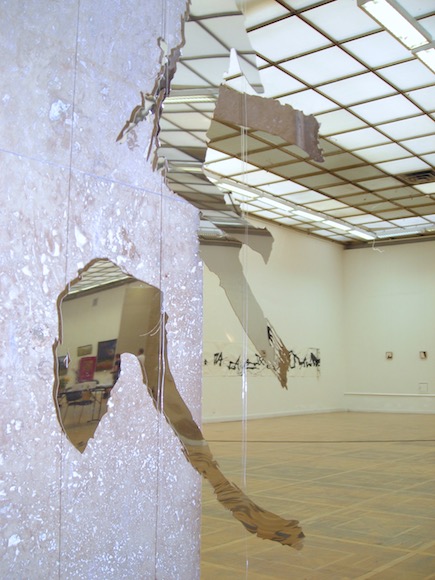
Central House of Artists Museum, Moscow
Installation view
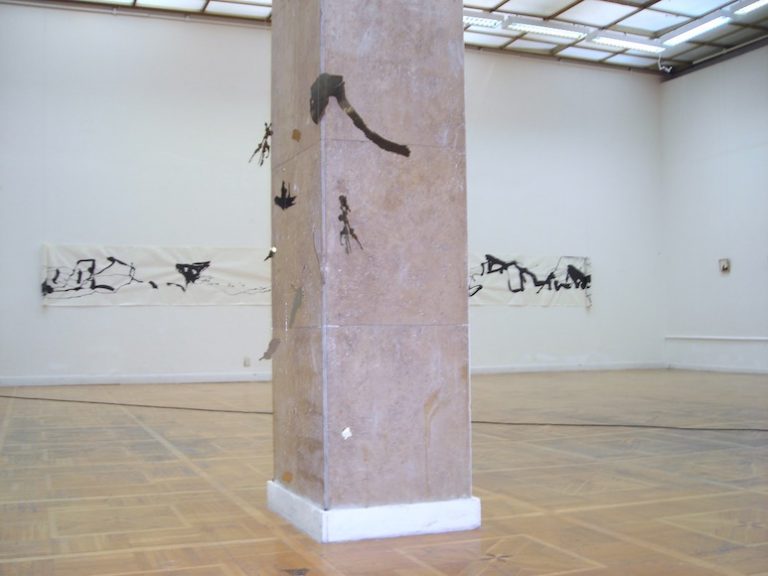
Central House of Artists Museum, Moscow
Installation view
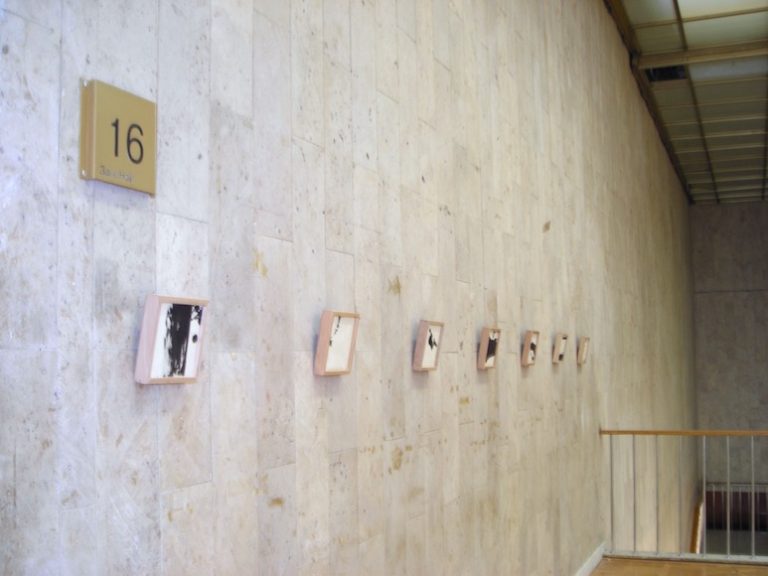
Central House of Artists Museum, Moscow
Installation view
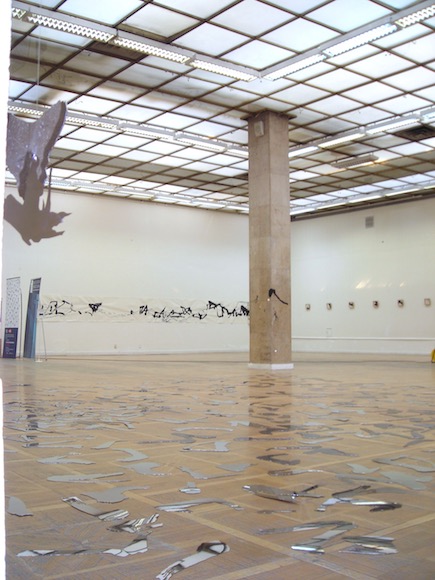
Central House of Artists Museum, Moscow
Installation view
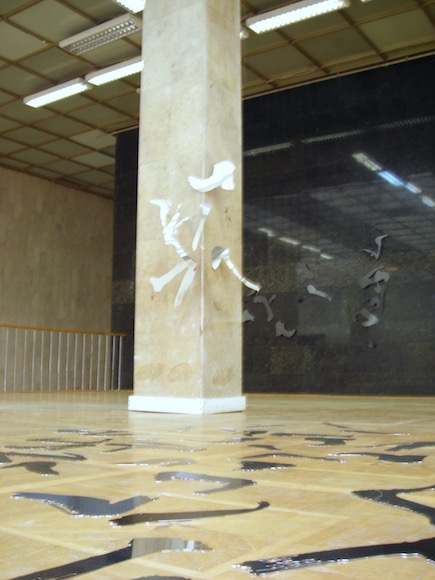
Central House of Artists Museum, Moscow
Installation view
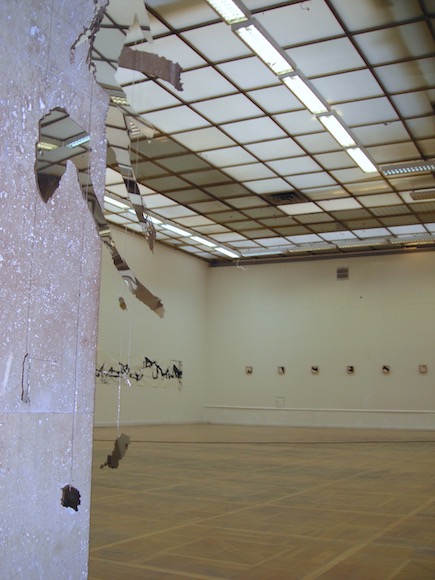
Central House of Artists Museum, Moscow
Installation view
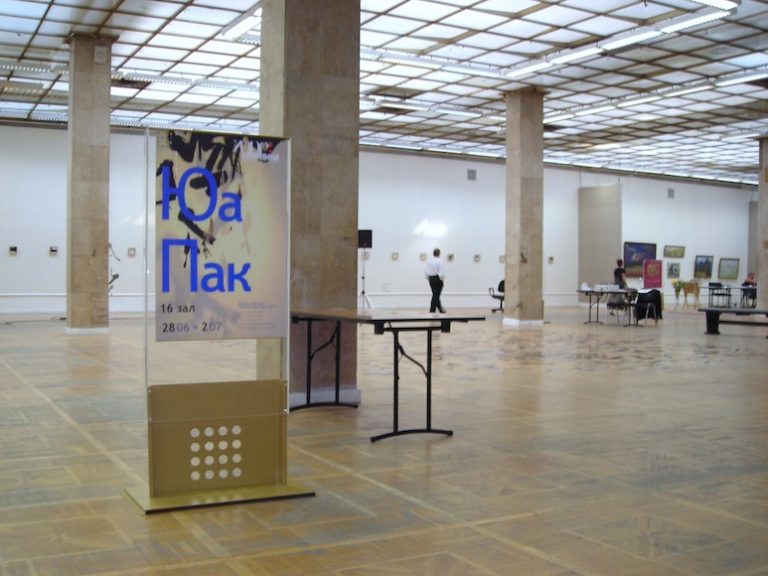
Central House of Artists Museum, Moscow
Installation view
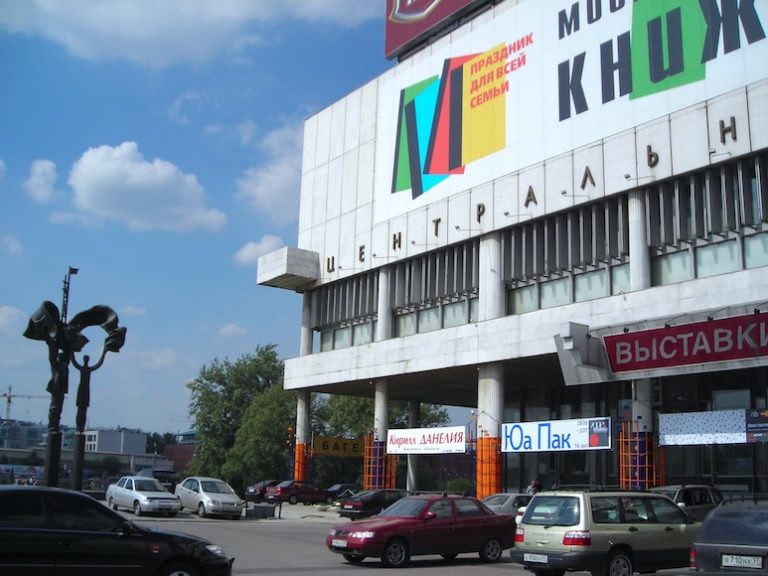
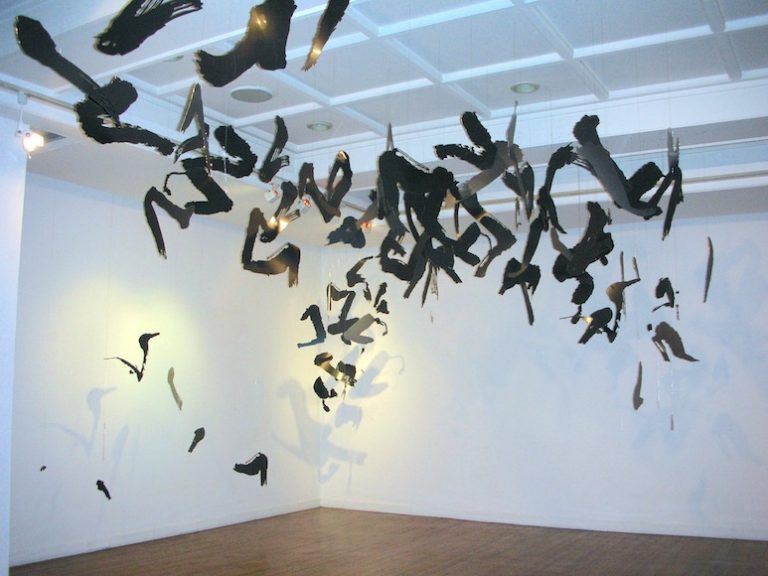
Center for Architecture and Design, Mexico City
Installation view
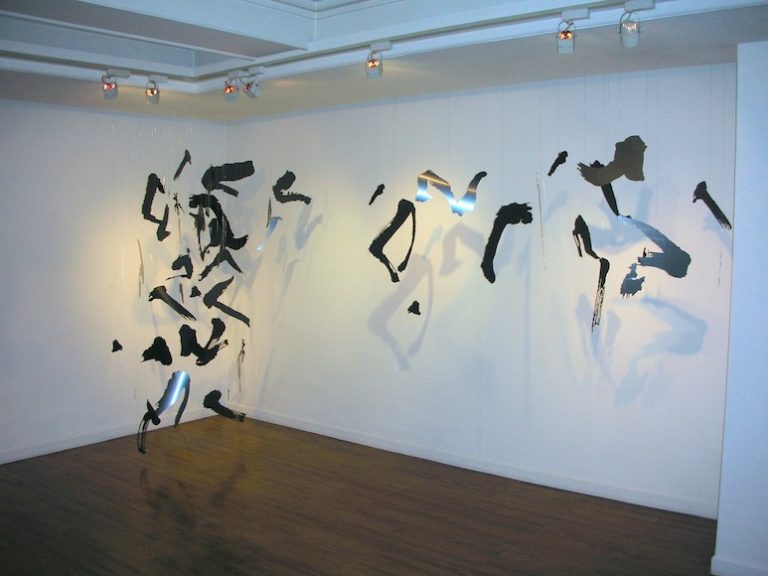
Center for Architecture and Design, Mexico City
Installation view
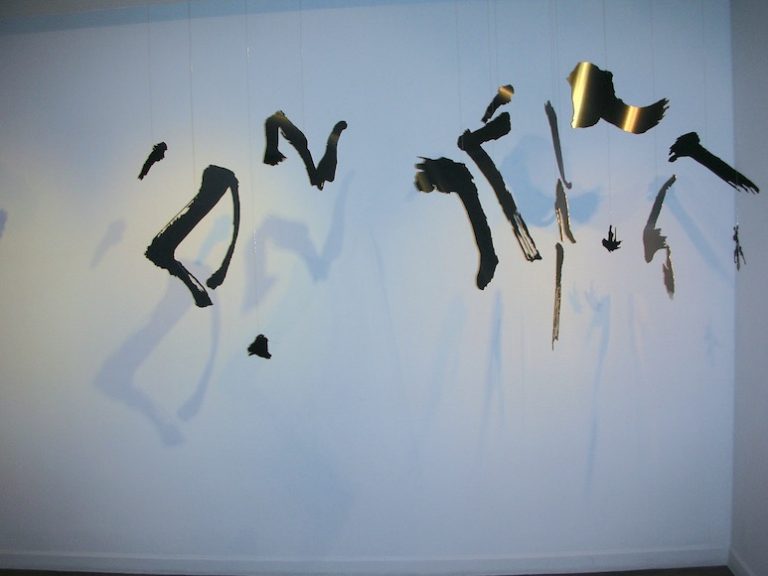
Center for Architecture and Design, Mexico City
Installation view
ZONE: Chelsea Center for the Arts is pleased to present “Writing in the Void,” a mobile of 280 calligraphic marks forged in black and silver aluminum by artist Yooah Park. Organized by ZONE: Chelsea, the exhibition will be held at the Central House of Artists Museum in Moscow, and travel to the Center for Architecture and Design, Mexico City (Aug. 10-Sept. 4).
Trained as a brush painter, Yooah Park explores gestural dynamics in painting and sculpture, combining influences from traditional Korean calligraphy artists, and Western artists such as Franz Kline, Agnes Martin, Brice Marden and Alexander Calder.
While Western philosophies typically depict the Void as an infinite absence, the Eastern notion of the Void is frequently described as a “formless field” inexplicably acting as the source and sustenance of all creation. In ancient Korean painting, the artist asserts, negative space is more important than positive space, presumably because of its “pre-rational” shaping intelligence. Following this logic, Park has activated and magnified this dynamism by setting her marks in three-dimensional space, mirroring the guided improvisation of John Cage’s chance techniques.
Perpetual motion also conveys the Buddhist belief in spirits inhabiting inanimate objects. Park’s figures cluster together in groups or stand in isolation as human figures do. And since the figures resemble fragments of ideograms, their suspension suggests a primordial arena wherein a language is first coalescing. This suspension reinforces the minimalist esthetic, the slowing down of time, and the sharpening focus – “the mental suspension, not a mental diversion” – experienced in meditation, as noted by Mark Levy in The Void in Art.
In the past, Park’s organic minimalism has employed multiples, such as her shifting grid of 63 ceramic cubes presented at ZONE: Chelsea in 2004. Always evident are her intimate calligraphic marks, which also adorned her chamber of hand-made tiles denoting Korean funeral ritual and the shedding of esthetic identities in “Rite of Passage” at the Gana Insa art Center in 2002. In April 2006, Park’s mobile installation appeared in a group exhibition at the Dong San Bang Gallery in Seoul.
The Central House of Artists Museum is located at 119049 Krymski val 10 exhibition hall #6, Moscow, Russia.
ZONE: Chelsea would like to thank CHA Director Vasily Vladimirovich Bychkov and Senior manager of the exhibition organizing deparment Marina Milishnikova.
Yooah Park
Writing in the Void
June 28 – July 3, 2006, Moscow
The Central House of Artists Museum
119049 Krymski Val 10 exhibition hall #16, Moscow, Russia
August 10 – September 4, 2006, Mexico
Galeria Emilia Cohen
Juan Vazquez de Mella No. 481, Col. Los Morales Polanco
Mexico D.F.C.P. 11510
I am pleased to present “Writing in the Void”, a mobile of 280 calligraphic marks forged in black and silver aluminum by artist Yooah Park. Organized by ZONE SATELLITE, a division at ZONE:Chelsea, Center for the Arts, the exhibition will be held at the Central House of Artists Museum in Moscow (June 28- July 3, 2006) and will travel to the Center for Architecture and Design, Mexico City (Aug 10 – Sep 4,2006).
Trained as a brush painter, Yooah Park explores gestural dynamics in painting and sculpture, combining influences from traditional Korean calligraphy artists, and Western artists such as Franz Kline, Agnes Martin, Brice Marden and Alexander Calder.
While Western philosophies typically depict the Void as an infinite absence, the Eastern notion of the Void is frequently described as a “formless field” inexplicably acting as the source and sustenance of all creation. In ancient Korean painting, the artist asserts, negative space is more important than positive space, presumably because of its “pre-rational” shaping intelligence. Following this logic, Park has activated and magnified this dynamism by setting her marks in three-dimensional space, mirroring the guided improvisation of John Cage’s chance techniques.
Perpetual motion also conveys the Buddhist belief in spirits inhabiting inanimate objects. Park’s figures cluster together in groups or stand in isolation as human figures do. And since the figures resemble fragments of ideograms, their suspension suggests a primordial arena wherein a language is first coalescing. This suspension reinforces the minimalist esthetic, the slowing down of time, and the sharpening focus ‘The mental suspension, not a mental diversion” experienced in meditation, as noted by Mark Levy in The Void in Art.
In the past, Park’s organic minimalism has employed multiples, such as her shifting grid of 63 ceramic cubes presented at ZONE: Chelsea, Center for the Arts in 2004. Always evident are her intimate calligraphic marks, which also adorned her chamber of hand-made tiles denoting Korean funeral ritual and the shedding of esthetic identities in “Rite of Passage” at the Gana lnsa Art Center in 2002. In April 2006, Park’s mobile installation appeared in a group exhibition at the Dong San Bang Gallery in Seoul.
I would like to thank Director Vasily Vladimirovich Bychkov and Marina Milishnikova, Senior Manager of the Exhibition Organizing Department at Cental House of Artists in Moscow. I would also like to thank Consul General Ramon Xilolt, Karina Escamilla, Program Coordinator at Mexican Cultural Institute of New York, Emilia Cohen, Director of Emilia Cohen Collection and Center for Architecture and Design in Mexico City. Special thanks to Erika Vilfort and Beatrize Ezban for their initial efforts in facilitating Yooah Paws Mexico exhibition and Kiril Milinishikov for his translations for the Moscow exhibition.
Jennifer Baahng ED.D
Director
ZONE: Chelsea, Center for the Arts
“Tonight he feels the potency of every word: words are only an eye-twitch away from the things they stand for.” —Thomas Pynchon, Gravity’s Rainbow
In his sprawling third novel, Pynchon grasped a tectonic shift in the modern era, as the industrial revolution yielded to the age of information. His international cast of misfits roams the shattered landscape of Europe at the close of World War II, no longer trading black-market cigarettes for weapons, machinery, or other tangible goods, but instead bartering with raw data—documents, patents, and even early computer codes, those ephemeral strings of 1’s and 0’s. One implication of this 1973 masterpiece is that humanity as a species is in danger of drifting from its moorings in the physical world, a condition that has come to pass with the alternate reality of cyberspace (a word that already sounds quaint, though it was coined only 20 years ago in William Gibson’s equally prescient novel, Neuromancer).
Yooah Park works in words as well, her art derived from expressive, calligraphic brushstrokes grounded in those immemorial ideograms first laid down millennia ago in ink on rice paper. Yet her newest work is disembodied; she has dispensed with any supporting surface, leaving her laser-cut steel brushstrokes hanging in midair. But like Pynchon’s “eye-twitch,” they remain beautifully corporeal, images that do double duty as “the things they stand for.”
How did Park arrive at this nexus of ancient symbols and (literally) cutting-edge technology?
One factor, no doubt, is travel, from her native Korea, where she received a degree in Oriental Painting, to graduate study in art history at Harvard and drawing at Columbia University. Another is her exploration of various surfaces as vehicles for her art, which has spanned drawing, painting, and sculpture. In the early nineties Park did a series of drawings that traversed the netherworld between figurative expression and pure abstraction, the form and subject reminiscent of Matisse’s bold dancers. Her images from this period are vibrant—leaping, pirouetting, twisting, and landing forms that spread across five-foot sheets of paper, and crouching, bending, lounging shapes compressed into smaller, one-foot squares. Quick arabesques and spatters of ink breathe life into the figures, and also work entirely as nonobjective form, both contained by and pushing at the boundaries of the paper, compositions that create exquisite tension.
Then came her work on clay tiles—calligraphic flourishes baked into the ash-colored mud, the litheness of her gestures mitigated somewhat by the elegiac gray surface. The stiff brushes she uses leave deeply incised ridges in the wet clay that feel, after being fired in a traditional Korean kiln, like fossils, giving both the image she has inscribed and the idea it conveys a sense of deep time, a shrouded past before the invention of writing, drawing, ink, or paper. Sometimes Park sculpts hexagons from this material: small smoky boxes in rows or scattered on the ground, her brushstrokes like weathered, mysterious inscriptions on tombstones. These shapes revisit her square drawings, retaining their coiled tension between the idea and its expression.
Park’s 2002 installation, Rite of Passage,went even further in this journey through idea and form, eschewing any sense of figuration or ideogram, leaving only walls of ashen tiles and hanging strips of handmade pulp paper to envelope the viewer. This tomblike enclosure returned her to art’s most basic element: a bare surface on which to project one’s imagination. In this case, the idea was writ large—the surface became an environment that at once enclosed and expressed a conscious negation of her earlier tools and techniques. A blank slate, in other words.
Fast-forward to the present. Other artists have hung objects from the ceiling—think of the colorful, playful geometries of Calder’s mobiles and Eva Hesse’s gloppy ropes and distended blobs suspended in mesh bags. More recently, the Spanish artist Jaume Plensa filled a New York gallery with curtains of stainless-steel letters that at a distance overlapped into a shimmering tower of Babel, an incomprehensible jumble of characters; only on closer inspection did it become apparent that the letters spelled out excerpts from the Bible’s Song of Songs.It is the curse of language that letters and words must be joined together to express thought, and that those sentences, paragraphs, and entire books remain intellectual abstractions— symbols—of what they represent.
Park, though, has the advantage over writers (or artists using letter forms) of translating thought and emotion into emphatic form through the bodily gestures of her brushstrokes. This is why the athletic traceries of her earlier drawings and clay pieces feel so alive; like those macho “action painters” the abstract expressionists, the movements of her arms, shoulders, torso—her entire body—come across in her energetic strokes of ink, her forceful scoring of clay. Now she has taken her gestures and removed them from any friction with a ground, be it paper or clay, to exist simply in the air. Cut from dark, shiny steel, these palpable strokes are hung in groups, and work on several layers. First, they are individual shapes, each filled with the verve of the original painted stroke (which is used as a template for the laser). But they also work as a whole, coalescing into various shapes as the viewer walks around and within this fragmented aerie. From some angles they seem a single entity that has burst apart and been frozen in time; from others it is as if they desire to gather together, like filings around a magnet. Always, though, they are physical manifestations of the artist’s search for form—idea, thought, and emotion transformed into a graceful dance.
R.C. Baker is a writer and artist who lives in New York City. His column, Best In Show,appears weekly in the Village Voice.
Related:

Yooah Park: “Writing in the Void”
Categories: spotlight
Tags: Yooah Park
YOOAH PARK
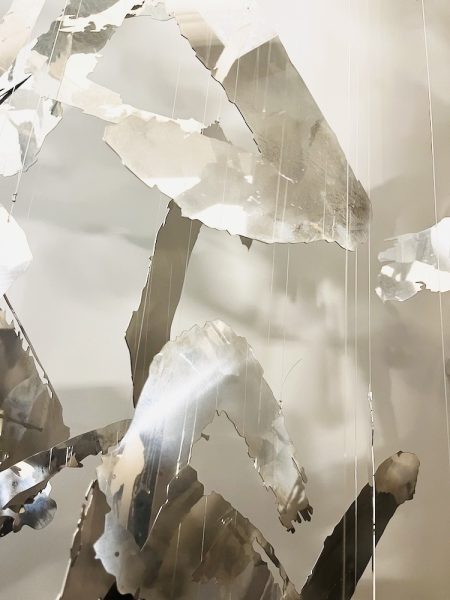
Void in Writing (detail), 2024
Stainless steel, plexiglass, piano string
A site-specific installation
Dimension varies
ZONE: Chelsea Center for the Arts is proud to present the second solo exhibition of the gallery artist Yooah Park. This exhibition showcases the many facets of her recent work, as she takes her signature fusion of inherited Asian art forms and Western abstraction in excitingly new directions.
Park’s new work represents an imaginative leap forward, but this flowering is rooted in her understanding of traditional techniques. Trained as a brush painter, she is extending the gestural language of calligraphy into unexpected forms and mediums. In a suite of 100 small, square paintings Park abandons the brush; instead she finger paints directly onto the translucent, skin-like fabric of liquid vinyl, with the visceral intensity of an abstract Expressionist.
Her blood-red medium is Inju, concocted from cinnabar, perilla oil and cotton. The color and viscosity of the medium allude to sealing wax, colophon signatures and Gyong-myon-ju-sa, the red mineral pigment used in Korean Bujeok, talismans fashioned to ward off evil spirits. The mix of cinnabar, mercury and sulfur in Gyong-myon-ju-sa represents a balance between positive and negative forces. The delicate and potentially dangerous ritual of mixing diverse elements lives at the root of the ancient mystical science of alchemy.
Ceramics have historically been an integral part of Korean culture. For the current exhibition, Park has hand shaped 13 monumental porcelain rice bowls, symbols of renewal and vitality. These majestic vessels – 32 ½ inches in diameter, 14 ½ inches tall – engulf the exhibition space, but the delicacy of the celadon glaze makes them seem weightless. It is as if the free spirit within the clay had been liberated. The gentle irregularities of the bowls are eloquent reminders of the casting process in which dynamic natural forces are guided by the artist’s shaping hand and eye.
Yooah Park was born in Seoul, Korea and currently works and resides in New York City. She has exhibited extensively abroad, including Seoul, Paris, New York, Beijing, and Tokyo. Her largest exhibition “Writing in the Void” was shown at the Center for Architecture and Design in Mexico City and at the Central House of Artists Museum in Moscow. Several of her works are also in international art museum collections.
YOOAH PARK
Solo exhibition
March 7 – March 29, 2008
Opening Reception
6-8PM, Friday March 7
Yooah Park combines the aesthetic traditions of her native Korea with twenty-first century global technologies. This exhibition showcases the many facets of her recent work, as she takes her signature fusion of inherited Asian art forms and Western abstraction in excitingly new directions.
Ceramics have historically been an integral part of Korean culture. In 2004, ZONE presented Park’s 63 Cubes, heavy, solid forms in an elegiac matte charcoal color that alluded to temple tiles and funeral rites. For the current exhibition, Park has hand shaped thirteen monumental porcelain rice bowls, symbols of renewal and vitality. These majestic vessels – 32 ½ inches in diameter, 14 ½ inches tall – engulf the exhibition space, but the delicacy of the celadon glaze which is the color of a lunar moth’s wings, makes them seem weightless. It is as if the free spirit within the clay had been liberated. The gentle irregularities of the bowls are eloquent reminders of the casting process in which dynamic natural forces are guided by the artist’s shaping hand and eye.
Park’s new work represents an imaginative leap forward, but this flowering is rooted in her understanding of traditional techniques. Trained as a brush painter, she is extending the gestural language of calligraphy into unexpected forms and mediums. She laser-cuts brushstroke characters out of aluminum, then, suspends them as mobiles in an installation of cascading columns. Paper-thin, reflective and dangerously sharp-edged, they slice through the air with the physical energy of Action painting and the cool clarity of twenty-first century techno-modernism. She has freed calligraphy from the two dimensions of paper and ink and given writing a precarious sculptural identity of kinetic art.
The riff on calligraphy continues with a suite of 200 small, square paintings. Liquid vinyl, a synthetic material used by contemporary fashion houses, provides the non-traditional support. Park abandons the brush; instead she finger paints directly onto the translucent, skin-like fabric, with the visceral intensity of an abstract Expressionist. Her blood-red medium is Inju, concocted from cinnabar, perilla oil and cotton. The color and viscosity of the medium allude to sealing wax, colophon signatures and Gyong-myon-ju-sa, the red mineral pigment used in Korean Bujeok, talismans fashioned to ward off evil spirits. The mix of cinnabar, mercury and sulfur in Gyong-myon-ju-sa represents a balance between positive and negative forces. The delicate and potentially dangerous ritual of mixing diverse elements lives at the root of the ancient mystical science of alchemy.
Metamorphosis results when traditional knowledge is combined with a bold spirit of experimentation. Park’s sequence of red paintings constitutes both a personal diary and a record of the creative process. The goal of true alchemy, the philosopher’s stone that turns base material into gold, is the process that leads to self-understanding. Park breathes new life into raw materials – clay, pigment, metal, synthetic – through the incantatory power of words and gestures.
– Dr. Jennifer Baahng
Yooah Park currently resides in the New York area, but frequently travels to her native Korea. For years she has studied and traveled between the two places, and her artwork reflects this dual identification. At first glance, the use of black ink and brush on handmade paper in a free and gestural manner belie the artist’s Asian background, but there is a decidedly Western element here that is less obvious. Park’s paintings are characterized by a lyrical sense of movement. This is related to the artist’s practice of painting from a live dancer performing in her studio, so that her paintings might have a greater quality of flowing grace. This art, therefore, which some would link to an Asian tradition of brush calligraphy, is also intimately connected with the study of the human form that has preoccupied Western art since the Renaissance.
Yooah Park’s pieces are filled with forms that seem to tumble and glide beyond the frame into an infinite space established by the diaphanous layers of carefully-laid paper. This is a space first articulated by the American canvas painters of the postwar New York school; Park brings it forth here through the use of materials with centuries of Asian heritage.
In today’s art world there is much talk of “bridging East and West.” Rarely do we see a vision that accomplishes such an integration. Neither Asian nor American, but rather a joyous fusion of the two, the art of Yooah Park succeeds as a new synthesis of aesthetic strengths from both spheres.
Solo Exhibitions
2006 Writing in the Void
The Central House of Artists Museum, Moscow, Russia
The Center for Architecture and Design, Mexico City, Mexico
2004 ZONE: Chelsea Center for the Arts, NY
2003 Gana Insa Art Center, Seoul
2002 Gana Insa Art Center, Seoul
2001 Andrew Bae Gallery, Chicago
2000 Hudson River Gallery, NY
1999 Jean Art Gallery, Seoul
1998 Space Untitled, NY
1997 Shirota Gallery, Tokyo
Gallery Bhak, Seoul
1996 Gallery Simon, Seoul
MANlF Seoul International Art Fair, Seoul
MAC 2000, Paris
1995 Seorim Gallery, Seoul
Gallery Ihn, Seoul
’95 Seoul Art Fair (J&C Gallery), Seoul
1994 East-West Cultural Studies, NY
’94 Seoul Art Fair (J&C Gallery), Seoul
1993 Sampoong Gallery, Seoul
1990 Jadite Galleries, NY
Selected Group Exhibitions
2007 ZONE: Chelsea Center for the Arts, New York, NY
2006 ZONE: Chelsea Center for the Arts, New York, NY
2004 Korean Contemporary Art,
Forum Gallery, Dallas, TX
2003 Best Star, Best Artist,
Gana Insa Art Center, Seoul
2002 KCAF, Seoul, Korea
Works on Paper, New York
Art of Pacific Asia, New York
2001 KCAF, Seoul, Korea
Works on Paper, New York
Art of Pacific Asia, New York
Kwangju International Ceramic Expo,
Kwangju, Korea
2000 ACAF, Sydney, Australia
Art Miami, Miami, FL
Works on Paper, New York
Art of Pacific Asia, New York
1999 NICAF, Tokyo, Japan
ACAF, Sydney, Australia
Works on Paper, New York
Art of Pacific Asia, New York
1998 NICAF, Tokyo, Japan
SIAF, Seoul, Korea
Art Miami, Miami, FL
1997 NICAF, Tokyo, Japan
MANIF, Seoul, Korea
SIAF, Seoul, Korea
1996 MANIF, Seoul, Korea
SIAF, Seoul, Korea
IN THE ATRIUM
Yooah Park
VOID IN WRITING
September 3 – December 28, 2024
JENNIFER BAAHNG Hannam
Yooah Park’s Void in Writing is installed in the ATRIUM in Hannam. It is a sculptural mobile made of laser-cut stainless steel suspended by piano strings, soaring 20 feet tall and cascading to the floor. This monumental presentation intrigues and piques the audience’s desire to walk around and contemplate it, enriching TRANSPACIFIC’s rich tapestry of contemporary art.
Related:

Yooah Park: “Writing in the Void”
Categories: exhibitions
Tags: Yooah Park
